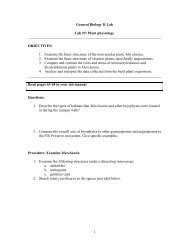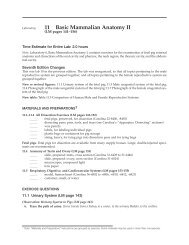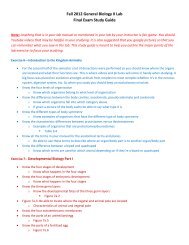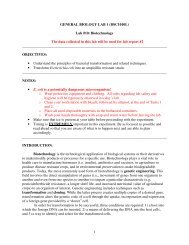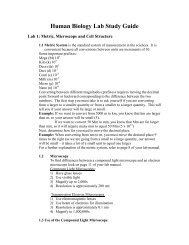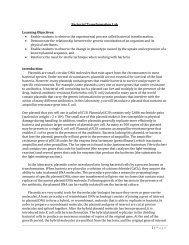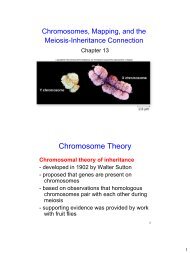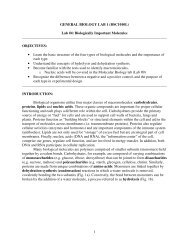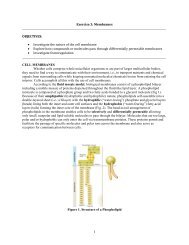Lab #7: Introduction to the Kingdom Animalia
Lab #7: Introduction to the Kingdom Animalia
Lab #7: Introduction to the Kingdom Animalia
You also want an ePaper? Increase the reach of your titles
YUMPU automatically turns print PDFs into web optimized ePapers that Google loves.
In general, members of <strong>Kingdom</strong> <strong>Animalia</strong> are eukaryotic, multicellular, motile (at least<br />
during certain developmental stages), heterotrophic and unlike plants, lack a cell wall.<br />
Additionally, most animals reproduce sexually and have a characteristic pattern of embryonic<br />
development. Similar <strong>to</strong> alternation of generations observed in previous phyla, organisms in <strong>the</strong><br />
Animal kingdom undergo stages of development, starting from <strong>the</strong> fusion of an egg and a sperm<br />
and ending with a multicellular adult phase. While <strong>the</strong> morphology of <strong>the</strong> adult organism is<br />
highly species-specific, <strong>the</strong> genes that regulate organismal development are often conserved<br />
across species. In addition, <strong>the</strong> life cycles of members of <strong>Kingdom</strong> <strong>Animalia</strong> vary considerably,<br />
i.e., <strong>the</strong> stages may look completely different from each o<strong>the</strong>r (metamorphosis), <strong>the</strong>y may last<br />
for different periods of time (hours vs. years) and can occur in different habitats (e.g. dragonflies<br />
- adults live in air while larvae are aquatic).<br />
Figure 2. Phylogenetic tree of members of <strong>Kingdom</strong> <strong>Animalia</strong><br />
______________________________________________________________________________<br />
Task 1: Understanding <strong>the</strong> hierarchical organization of animal complexity<br />
The common descent of animals within <strong>Kingdom</strong> <strong>Animalia</strong> can be observed in <strong>the</strong><br />
organization of body plans and <strong>the</strong> fundamental building blocks that all animals share. Unique<br />
and shared characteristics among members of <strong>the</strong> animal kingdom are convincing evidence that<br />
<strong>the</strong> group is monophyletic (i.e. a group that shared a common ances<strong>to</strong>r and all its members). The<br />
2



